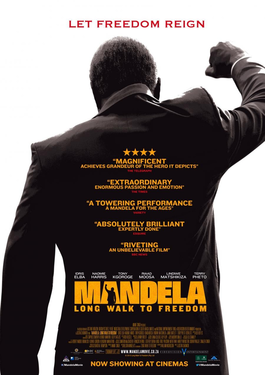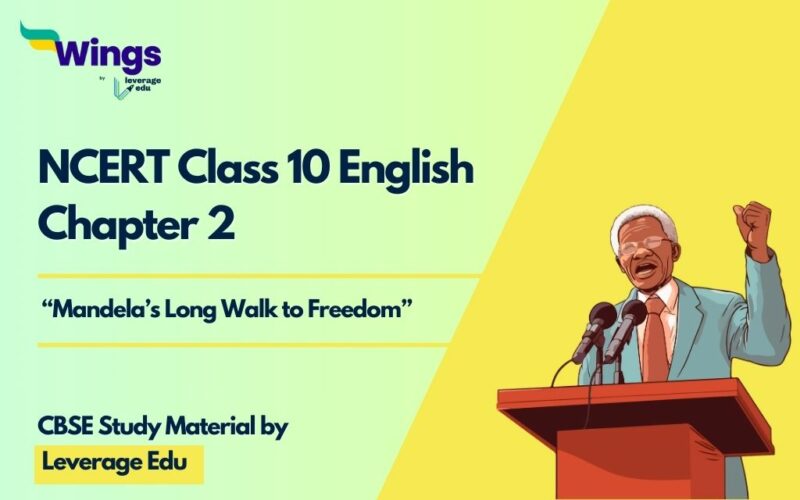A Long Walk to Freedom is the 2nd chapter of the Class 10 English syllabus, which is the autobiography of Nelson Mandela, the anti-apartheid revolutionary and first black prime minister who served South Africa from 1994 -1999. The following is the summary of A Long Walk to Freedom Class 10 and the prose section which includes Mandela’s inauguration ceremony and excerpts from his speeches which illustrate the struggles Mandela had to undergo as a freedom fighter. Let’s learn everything about a long walk to Freedom Class 10 notes.
This Blog Includes:

A Long Walk to Freedom Class 10 PDF
Nelson Mandela A Long Walk to Freedom Class 10 Summary
After nearly three centuries of white supremacy in South Africa, the country witnessed its first Black President, Nelson Mandela who be won the first and foremost democratic elections on May 10, 1994. Mandela’s party clocked in a historic win with 252 votes out of 400. A Long Walk to Freedom chapter in Class 10 is an extract from Nelson Mandela’s autobiography which elucidates the struggle faced by the black community in South Africa riddled with apartheid. Here is a summary of A Long Walk to Freedom:
- Mandela took his oath as the President in the Union Buildings amphitheatre in Pretoria in the presence of several prominent political figures and world leaders across the globe. He commenced his speech by addressing all the dignitaries and assured the citizens they would never experience similar suppression of one group over another.
- Nelson Mandela vowed that in the democratic country that he’d established there would never be discrimination against people, irrespective of caste, colour, creed or race and that government would treat people with due respect and equality.
- On this historic inauguration, the country’s citizens sang 2 national anthems. The white people sang ‘Nkosi Sikelel –iAfrika’ and the black people recited the iconic ‘Die Stem’ which was a stark reminder of the exploitation of the black community in South Africa.
- Deeply pained by the racist history, Nelson Mandela said that this type of discrimination of black people in their very own land was one of the harshest and most inhuman the world had ever known. He emphasised that people are not born to hate others on the basis of skin colour, background or religion and they can be taught to love because love comes naturally to human beings than hate.
Must Read: Nelson Mandela International Day

- An important part of Mandela’s speech in A Long Walk to Freedom Class 10 extract, Mandela stated that a man has 2 obligations in his life; one towards his family and the other towards his motherland, countrymen and community and as per their own interests and inclinations, man is able to fulfil these obligations. However, as a black man in a country like South Africa, Mandela found it increasingly difficult to do so. As he became an adult, Mandela saw freedom as an illusion for his community.
- Mandela further believed that freedom was indivisible for all. Still, he saw that the black community is facing oppression and tyranny. It emulated the profound idea that the oppressor must be liberated just like the oppressed because a person who snatches another’s freedom is also a prisoner of similar oppression. Therefore the oppressor wasn’t any freer than the oppressed because they were bound by the same chains of oppression.
Must Read: Education of Nelson Mandela

A Long Walk to Freedom Class 10 Notes
Here is a rundown of this chapter to help you quickly revise A Long Walk to Freedom by Nelson Mandela:
- The chapter Nelson Mandela: Long Walk to Freedom starts with Nelson Mandela talking about how it is a beautiful day for the country since they are getting their first non-white democratically elected government. He then tells the names of the people who become deputy Presidents before he takes his oath as the president in the presence of foreign dignitaries, people of his beloved country, army officials and his daughter – Zenani.
- This beautiful grand inauguration was the first and largest gathering of international leaders in South Africa. His first speech as the president of South Africa hails this glorious moment as the victory of justice, peace and human dignity, which has been achieved with great difficulty after a very long fight against Apartheid. He concludes the speech by pledging to uplift his country’s people from poverty, deprivation, suffering, and discrimination.
- He also describes all the beautiful things that happen in the ceremony, like the show that jets, troop carriers and helicopters do with beautiful stunts and colours of the African national flag. When the defence forces and police salute and pledge loyalty to him, he is mindful of how far they have come because a few years before this day, the same officers would have arrested him instead of saluting him. The 2 national anthems playing with the whites singing the African and the Africans singing the anthem, which the state previously used, symbolized the harmony and peace he wanted to see in his country.
- Mandela seems a little overwhelmed when he takes his contemporary fighters’ names who worked and sacrificed for their country’s freedom and this day. He feels he is “the total of all the African patriots” who came before him and is saddened that he cannot personally thank them for all that they did for the country. He says he is no more virtuous or self-sacrificing than the next man, but he discovered that he could not enjoy whatever little freedom he had with the knowledge that his people were not free either.
Must Read: How Does Nelson Mandela Define the Meaning of Courage?
In Nelson Mandela’s A Long Walk to Freedom, Mandela stated his belief that his country is rich in minerals and metals, but the people of his country were the real greatest wealth for him “finer and truer than the purest diamond”. Nelson Mandela believes “No one is born hating another person because of his skin colour or background or religion.”
According to Mandela, people are born free of such prejudices. He says that the oppressor and the oppressed both needed to be liberated – the oppressor from their inhuman condition and the oppressor from their prison of hatred. Believing that men learn to hate, he says they can learn to love, which is easier because love comes easier to people than hate.
Here is the speech by Nelson Mandela that is covered in this chapter:
Also Read: The Frog and the Nightingale Summary Class 10 English
A Long Walk to Freedom Class 10 PPT
Nelson Mandela Class 10 Questions and Answers
Here are some important questions and answers for A Long Walk to Freedom Class 10:
Ans. He referred to the heinous practice of apartheid as “an extraordinary human disaster”. During apartheid in South Africa, there was racial segregation which caused immense suffering to the black community. Demand for freedom or any kind of basic human right was a far-fetched dream. Mandela was himself imprisoned in the infamous “Robben Island” and beaten mercilessly. He considered becoming the 1st Black Prime Minister in South Africa a glorious achievement because South Africa was a country that would even regard black people as human beings let alone give them positions of power.
Ans. The book was published in December 1994. There is also a movie on it available on Netflix if you are interested to learn more about the book.
Ans. Mandela’s swearing-in ceremony was historic because not too long ago blacks were considered outlaws in their own motherland. Mandela was honoured to have the international leaders witness this historical moment. Not only was this a sign of international recognition of a newly born democratic South Africa, it was also the victory of peace, justice and humanity.
Ans. Growing up, freedom for Mandela meant making merry and living a blissful life. But as he grew he realized his childhood antics were wasteful from an adult perspective. As an adult freedom for him meant an honourable existence, earning one’s daily bread and fending for the family.
Ans. The story revolves around the theme of getting freedom after a very long struggle due to the courage of all the people who sacrificed so much for equality and peace in the country, much like India’s own freedom struggle. The celebration when a country gets its freedom is also shown in the story.
Ans. The moral of the story is that the oppressor and the oppressed both lose humanity. One through hatred and the other through oppression and hence both need to be liberated from these inhumane prisons. Mandela’s belief that people are born free of hatred and learn it later is also a very enlightening lesson we learn from the chapter. The people learn to hate and therefore they can also learn to love is a beautiful takeaway from the lesson.
Ans. Apartheid was the political system in South Africa due to which people were discriminated against based on their skin colour hence the native black people had almost negligible rights and freedom. The generals who would have arrested Nelson Mandela a few years ago saluted him and pledged their loyalty to him because he had been one of the key members in their fight against apartheid and now they had won the fight. Nelson was the new president and there was no difference between white and black.
Ans. On 10th May, 1994 the first democratically elected government was established with their first non-white president as Nelson Mandela in South Africa. Hence it is a moment of glorious historical significance for the country.
Ans. According to Nelson Mandela, a man has two obligations in his life. One is towards his family and friends the other is towards his people and country.
Ans. For Nelson Mandela, Courage doesn’t mean the lack of fear but acceptance and winning over it. He learnt the true meaning of courage from thousands of freedom fighters and people who gave countless sacrifices for their country.
Test your knowledge about A Long Walk to Freedom with this fun quiz.
A Long Walk to Freedom Quiz

Related Reads
FAQs
Ans. Mandela wanted freedom for himself as a student.
Ans. My country is rich in the minerals and gems that lie beneath its soil, but I have always known that its greatest wealth is its people, finer and truer than the purest diamonds.
Ans. In the chapter, the author has talked about two obligations for every man. The first obligation is towards his family, parents, his wife, and children. The second is towards his community and his country. Being a social person one has to fulfil these obligations.
This was all about the A Long Walk to Freedom Class 10 Notes. We hope you find these notes useful. Confused about the best stream after 10th? Sign up for a free session with our counsellors at Leverage Edu and we will help you select the best field as per your interests and preferences.

 One app for all your study abroad needs
One app for all your study abroad needs























 45,000+ students trusted us with their dreams. Take the first step today!
45,000+ students trusted us with their dreams. Take the first step today!


